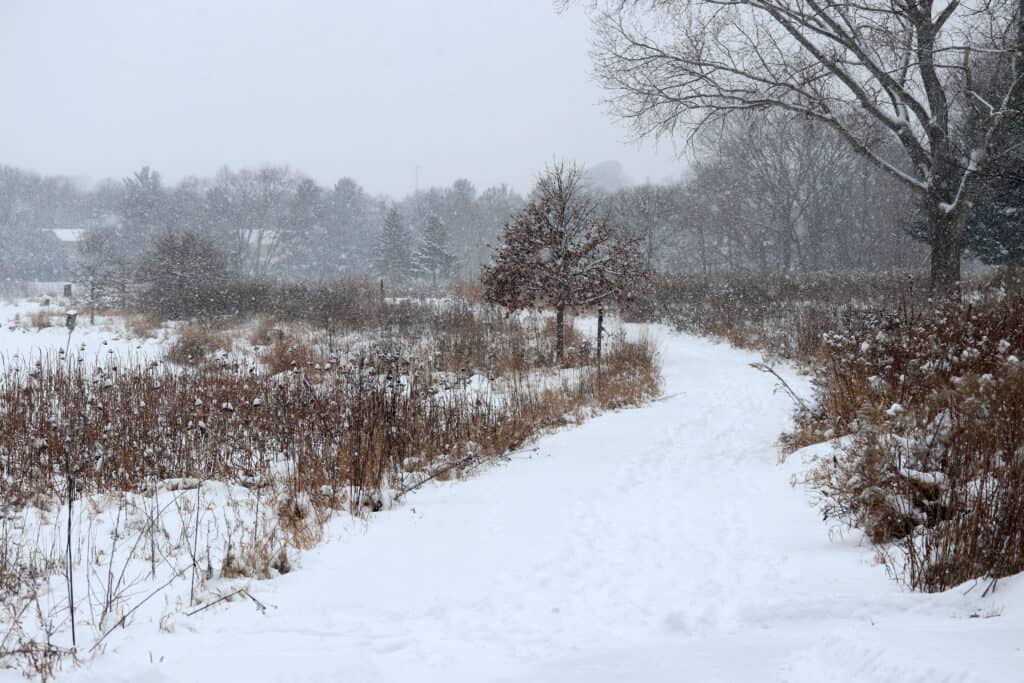The state of Wisconsin is no stranger to snow, but when does the first snow in Wisconsin typically fall? Bordered by the Great Lakes and a number of different frigid states, Wisconsin experiences heavy snowfall during the wintertime. But how much snow does Wisconsin experience on average, and when does the winter season typically begin?
In this article, we will go over everything you need to know about the first snowfall in the state of Wisconsin, including whether or not there are any years outside the norm. We’ll also address how much snow Wisconsin typically gets, as well as any years that experienced heavy snowfall and blizzard conditions. Let’s get started and talk all about snow in Wisconsin now!
Understanding First Snow in Wisconsin

All of Wisconsin experiences snow at some point during the wintertime, even if it’s only a couple of feet.
©MarynaG/Shutterstock.com
| Wisconsin Snow Facts | |
|---|---|
| Earliest First Snowfall | September 7 (1983) |
| Latest First Snowfall | January 19 (1961) |
| Average Temperature | 5-35 degrees Fahrenheit |
| Largest Seasonal Snowfall | 301 inches (1996-1997) |
| Smallest Seasonal Snowfall | 21 inches (1967-1968) |
| Places to Enjoy the Snow | Kettle Moraine State Forest, Madison, Apostle Islands |
One of the first things you need to understand about the state of Wisconsin is the fact that one region of the state experiences far more snow than the rest of the state. However, it’s safe to assume that all of Wisconsin experiences snow at some point during the wintertime, even if it’s only a couple of feet.
Colloquially known as the Snowbelt region, the northern regions of Wisconsin, bordering Lake Michigan, experience the most snowfall during the wintertime. In fact, the average snowfall for the majority of Wisconsin is anywhere from 40 to 50 inches annually, but the Snowbelt region of Wisconsin experiences 100 to 150 inches annually. This is a significant difference, largely attributed to the lake effect which involves cool air traveling over warm waters and resulting in large amounts of snowfall.
But this still doesn’t answer the question: when does the first snow in Wisconsin typically fall?
Earliest and Latest Snowfalls in Wisconsin
On average, the first snow in Wisconsin typically falls during the last week of October or the first week of November. However, there are always exceptions to the rules, and one of the earliest known first snowfalls in the state’s history occurred on September 7th, 1983. While this occurred in the Snowbelt region of the state, it still counts as the earliest first snowfall in Wisconsin’s history!
In direct contrast to this early first snowfall date, January 19th, 1961 was recorded as the latest first snowfall date in Wisconsin’s history. When you consider the fact that snow begins earlier than average in Wisconsin compared to the rest of the country, January 19th is incredibly late for snow to begin!
As you can no doubt guess, Wisconsin residents are no strangers to snowfall, but how much snow typically falls on average, and have there been any years that are more extreme than others?
Largest and Smallest Snowfalls in Wisconsin

The average snowfall for the majority of Wisconsin is anywhere from 40 to 50 inches annually, but the Snowbelt region of Wisconsin experiences 100 to 150 inches annually.
©Keith Erlandson/Shutterstock.com
As a whole, the United States averages 28 to 35 inches of snow annually. However, Wisconsin is typically far above this average, especially when you consider the fact that one of their smallest seasonal snowfall years happened in 1967 to 1968. This wintertime only saw 21 inches of snow for the entire season, a minimal amount when compared with other Wisconsin winters. However, 21 inches is still significant compared to the rest of the country, particularly the average for the United States as a whole.
On the flip side of this smallest snowfall record lies the largest record, which occurred in the winter season of 1996 to 1997. While this record occurred in the Snowbelt region of Wisconsin, a record-setting 301 inches of snow fell during this season, nearly tripling the average amount of snow that Wisconsin typically sees!
Winter Temperatures in Wisconsin
Just like the varying snow amounts found throughout the state, Wisconsin has very different temperatures depending on where you live. The northernmost regions of Wisconsin are far colder compared to southern Wisconsin, especially when you consider the fact that the Snowbelt is also located in northern Wisconsin.
Taking a closer look at the figures, northern cities and towns in Wisconsin average anywhere from 5 to 25 degrees Fahrenheit during the months of January and December. Locations such as Milwaukee and Madison experience slightly milder winters, with an average temperature of 15 to 35 degrees Fahrenheit. However, there are always winter storms that bring temperatures in the negatives alongside piles of fresh snow!
Winter Wildlife in Wisconsin

The northernmost regions of Wisconsin are far colder compared to southern Wisconsin.
©Ondrej Prosicky/Shutterstock.com
Whether you plan on staying indoors or exploring all of the state and national parks Wisconsin has to offer, you’re likely to run into some wildlife in the state. Even in the wintertime, here’s a list of some of the animals you are likely to see in Wisconsin should you choose to visit:
Up Next
- First Snow in North Dakota: The Earliest & Latest First Snows on Record
- First Snow in West Virginia: The Earliest & Latest First Snows on Record
- First Snow in Vermont: The Earliest & Latest First Snows on Record
The photo featured at the top of this post is © Lynn_Bystrom/Shutterstock.com
Sources
- First Snowfalls of the Season, Available here: https://www.weather.gov/grb/FirstSnowfallsOfTheSeason#:~:text=The%20first%20snowfall%20of%20the,Fox%20Valley%20and%20lakeshore%20region.
Thank you for reading! Have some feedback for us? Contact the AZ Animals editorial team.






